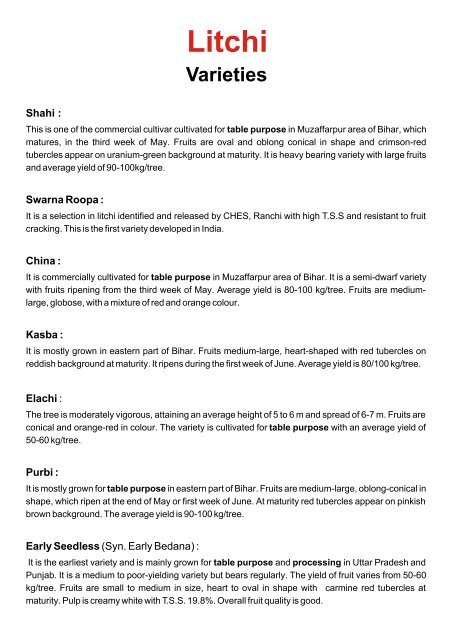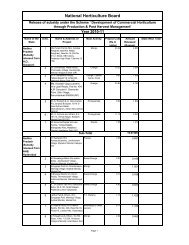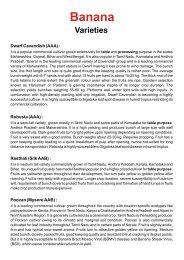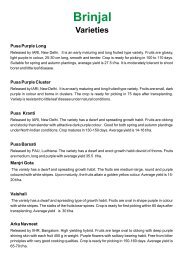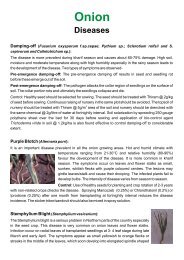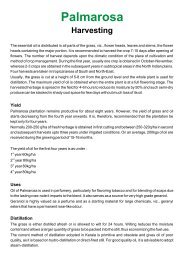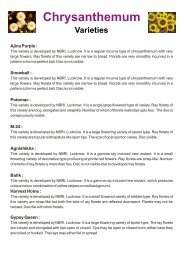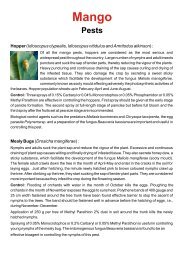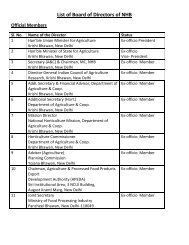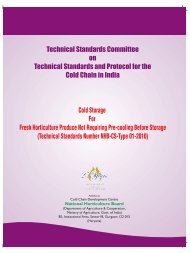Litchi Varieties
Litchi Varieties
Litchi Varieties
Create successful ePaper yourself
Turn your PDF publications into a flip-book with our unique Google optimized e-Paper software.
Shahi :<br />
<strong>Litchi</strong><br />
<strong>Varieties</strong><br />
This is one of the commercial cultivar cultivated for table purpose in Muzaffarpur area of Bihar, which<br />
matures, in the third week of May. Fruits are oval and oblong conical in shape and crimson-red<br />
tubercles appear on uranium-green background at maturity. It is heavy bearing variety with large fruits<br />
and average yield of 90-100kg/tree.<br />
Swarna Roopa :<br />
It is a selection in litchi identified and released by CHES, Ranchi with high T.S.S and resistant to fruit<br />
cracking. This is the first variety developed in India.<br />
China :<br />
It is commercially cultivated for table purpose in Muzaffarpur area of Bihar. It is a semi-dwarf variety<br />
with fruits ripening from the third week of May. Average yield is 80-100 kg/tree. Fruits are mediumlarge,<br />
globose, with a mixture of red and orange colour.<br />
Kasba :<br />
It is mostly grown in eastern part of Bihar. Fruits medium-large, heart-shaped with red tubercles on<br />
reddish background at maturity. It ripens during the first week of June. Average yield is 80/100 kg/tree.<br />
Elachi :<br />
The tree is moderately vigorous, attaining an average height of 5 to 6 m and spread of 6-7 m. Fruits are<br />
conical and orange-red in colour. The variety is cultivated for table purpose with an average yield of<br />
50-60 kg/tree.<br />
Purbi :<br />
It is mostly grown for table purpose in eastern part of Bihar. Fruits are medium-large, oblong-conical in<br />
shape, which ripen at the end of May or first week of June. At maturity red tubercles appear on pinkish<br />
brown background. The average yield is 90-100 kg/tree.<br />
Early Seedless (Syn. Early Bedana) :<br />
It is the earliest variety and is mainly grown for table purpose and processing in Uttar Pradesh and<br />
Punjab. It is a medium to poor-yielding variety but bears regularly. The yield of fruit varies from 50-60<br />
kg/tree. Fruits are small to medium in size, heart to oval in shape with carmine red tubercles at<br />
maturity. Pulp is creamy white with T.S.S. 19.8%. Overall fruit quality is good.
Rose Scented :<br />
It is commercially cultivated for table purpose in Muzaffarpur area of Bihar. Besides high fruit quality, it<br />
is famous for distinct rose aroma and hence called Rose Scented. It is a mid-season variety that starts<br />
ripening in the first week of June. Average yield is around 80-90 kg/tree. Fruits are medium to large in<br />
shape mostly oval or heart shaped and deep rose pink in colour. Pulp greyish white soft moderately<br />
juicy with T.S.S. 20%. The average yield varies between 80-90kg/tree.<br />
Bombai :<br />
This is an important commercial variety cultivated for table purpose in West Bengal. It ripens during<br />
first to second week of May. The trees are vigorous and attain an average height of 6.7 m and spread 7-<br />
8 m. Average yield is 80-90 kg/tree. Fruits are large in size, mostly obliquely heart-shaped colour at<br />
maturity with carmine red tubercles on uranium-green background. In this variety each developed fruit<br />
has another tiny under-developed fruit attached to the fruit stalk. Pulp is greyish-white, soft juicy with<br />
T.S.S. 17%.<br />
Calcutta (Syn. Kalkattia) :<br />
It is the best of all the varieties grown in northern parts of India for table purpose. It can be successfully<br />
cultivated even in hotter areas provided there is protection from strong hot winds and provision for<br />
plenty of water for irrigation. The average yield is 80-100 kg/tree. It is a late season variety and the fruits<br />
ripen in the last week of June. Trees of this variety attain an average height of 4m and spread of 6 m.<br />
Fruits are large in size, oblong, with tyrian rose colour and dark tubercles at maturity. Pulp is dirty<br />
creamy white, soft, juicy, very sweet with T.S.S. 18.17%.<br />
Late Seedless (Syn. Late Bedana) :<br />
This variety is not completely devoid of seed but it is rather shrivelled and small in size. It can be<br />
successfully cultivated even in hotter areas provided there is protection from strong hot winds and<br />
provision for plenty of water for irrigation. The trees of this variety are very vigorous and attain an<br />
average height of 5.5 m and spread of 7.0m. It is a late season variety and fruits usually ripen in the third<br />
week of June, The average yield is 80-100 kg/ tree. Fruits are medium to large in size, conical in shape,<br />
colour at maturity vermilion to carmine with dark-blackish brown tubercles. Pulp is creamy- white, soft,<br />
juicy with T.S.S. 20% Overall quality is very good. It is cultivated for table and processing purpose.<br />
Dehra Dun :<br />
This variety is mainly grown for table purpose in Uttar Pradesh and Punjab. In Bihar, it is cultivated<br />
under the name of 'Dehra-Rose'. It is a late-season variety and fruits start ripening in third week of<br />
June. Fruit yield is 80-90 kg/tree. Trees are medium in size attaining a height of 5 m and spread of 7 m.<br />
Fruits are medium in size, obliquely heart-shaped to conical, colour at maturity bright rose pink. Pulp is<br />
greyish-white, soft moderately juicy with T.S.S. 17%. This variety is highly susceptible to sunburn and<br />
cracking.
Gulabi (Syn. Sre no.4) :<br />
This is another important variety cultivated for table purpose in north India. It is a late-season variety<br />
and fruit ripens in fourth week of June. It bears profusely and regularly with 90-100 kg fruits/tree. Trees<br />
attain a height of 6.0 m and spread of 7.0 m. Fruits are medium in size, oblong-oval heart-shaped,<br />
mandarin red tubercles appear on shrimp red to carmine red background at maturity. Pulp is greyish<br />
white, firm sweet with T.S.S. 18.2%.<br />
Late Large Red (Syn. Muzaffarpur) :<br />
It is one of the important litchi varieties mainly grown in Bihar and its adjacent states. This variety bears<br />
profusely every year with an average yield of 80-100 kg/tree. Fruits are large in size, oval or oblongconical<br />
with crimson red tubercles. Pulp greyish white. Soft moderately juicy with T. S. S. 20.3%.<br />
Exotic <strong>Varieties</strong><br />
China<br />
'No Mai Tsze', 'Kwa Iuk' , 'Kwai mi' , 'Hsiang li', 'Hsi Chio tsu', 'Hak ip', 'Feitsu hsiao', 'Sheung shu<br />
wai', 'Ch'u ma lsu', 'Ta tsao', 'Huai chih', 'San yueh hung', 'Pai la li chih', 'Shan chi'.<br />
Germany<br />
Mauritius, Maclean, Brewster, Haak Yip.


